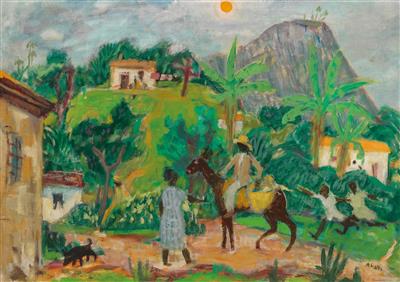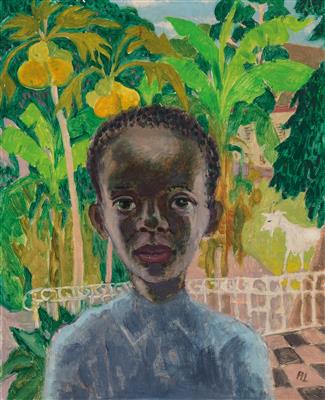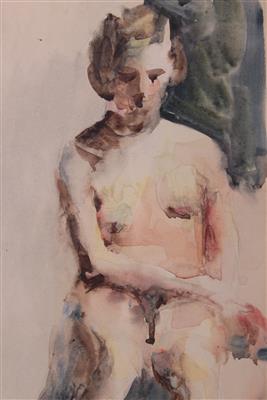AXL LESKOSCHEK* (Graz 1889 - 1976 Wien) Blumenstillleben, 1951 Öl/Leinwand, 100,5 x 70 cm monogrammiert AL und datiert 51 Provenienz: Galerie Ciwna, Kunsthandel Widder SCHÄTZPREIS: °€ 2.000 - 3.000 Österreichischer Maler des 20. Jahrhunderts v.a. der Zwischenkriegszeit. Hauptvertreter der Moderne und Avantgarde in der Steiermark. Studierte an der Landeskunstschule in Graz bei Alfred Schrötter und 1921 bis 1923 an der Graphischen Lehr- und Versuchsanstalt in Wien bei Alfred Cossmann Kulturredakteur bei der sozialdemokratischen Zeitung Arbeiterwille, ab 1920 auch Buchillustrator. 1919 Mitbegründer des Werkbundes Freiland, 1923 Grazer Secession. Flüchtete 1938 mit dem Architekt und Widerstandskämpfer Herbert Eichholzer über Italien in die Schweiz. 1941 bis 1948 Exil in Brasilien, Professor an der Akademie in Rio de Janeiro. 1948 Rückkehr nach Österreich. in Wien als Maler, Grafiker und Theaterkritiker tätig. Frühe Einflüsse vom Jugendstil und Expressionismus, später Interesse an mittelalterlichen Holzschnitte. Schuf farbintensive Ölbilder und Aquarelle, südliche Landschaften und Akte, auch exotische Blumenstillleben mit Calla und Papageienblume die an seine Zeit in Südamerika erinnern. Der Maler, Grafiker und Illustrator Axl Leskoschek wurde in Graz als Sohn eines Feldmarschallleutnants geboren und schloss 1917 – mitten im Ersten Weltkrieg – seine juristische Ausbildung mit dem Doktorat ab. Er wurde unmittelbar danach als Fliegerleutnant an die Front beordert, von der er schwer verwundet zurückkehrte. Unter dem Eindruck dieses einschneidenden Kriegserlebnisses verzichtete er auf eine Justizkarriere und begann an der Landeskunstschule Graz bei Alfred Schrötter und an der Grafischen Lehr- und Versuchsanstalt in Wien zu studieren. Mit seinen Holzschnitten zu den „Legenden des hl. Franziskus“ begründete er 1920 eine Reihe von Illustrationen zur Weltliteratur, wurde Mitbegründer des Werkbunds „Freiland“ (1919) und der Grazer Sezession (1923). Zur gleichen Zeit entwickelte er seine Hellhörigkeit für die politischen Umwälzungen dieser Umbruchszeit, in der er auch für die sozialdemokratische Tageszeitung „Arbeiterwille“ bis 1934 als Kulturredakteur tätig wurde. Schon 1920 entstand das erste von ihm mit Holzschnitten illustrierte Buch, dem bis zu seinem Tod über 50 weitere Bücher folgen sollten. Es sind vor allem expressionistische Bilder, mit denen Leskoschek am Beginn seiner Karriere an die Öffentlichkeit trat. Er betätigte sich aber nicht nur als Maler, Holzstecher und Schnitzer, sondern – zwischen 1928 und 1931 – auch als Bühnenbildner am Stadttheater in Augsburg sowie als politischer Aktivist. So beteiligte er sich als Mitglied des Schutzbundes am blutigen Arbeiteraufstand im Februar 1934, weswegen er sich nach kurzer Inhaftierung der illegalen KPÖ anschloss und 1936/37 im Anhaltelager Wöllersdorf neuerlich inhaftiert wurde. Während seiner Haft schuf er eine umfangreiche Folge allegorischer Blätter in expressiv-surrealem Stil. Noch gerade rechtzeitig gelang ihm 1938 die Flucht vor dem NS-Regime. Gemeinsam mit dem Architekten Herbert Eichholzer floh er über Triest in die Schweiz, von wo aus er gemeinsam mit seiner Frau, die er hier kennengelernt hatte, 1940 ins Exil nach Brasilien entschwand. Dort entstand eine Reihe von Ölbildern, Aquarellen, Linol- und Holzschnitten, Pochoirs, Lithografien und Radierungen. Ebenso unterrichtete er an der Akademie der Bildenden Künste in Rio de Janeiro Holzschnitt und Komposition und wurde so zum Lehrer einer ganzen Generation brasilianischer Künstler. Erst 1948 kehrte er nach Österreich zurück, wo er in der Zeit des Kalten Krieges als kommunistischer Aktivist für den Realismus in der Kunst eintrat und sein Werk offiziell kaum beachtet wurde. Erst durch internationale Ausstellungen in den 1960er Jahren konnte er eine gewisse Bekanntheit erlangen, während in Österreich Ausstellungen wie jene von 1954 zum Thema „Kunst und Widerstand“ boykottiert wurden. Kurz zuvor – 1952 – entstand auch dieses unverfän
AXL LESKOSCHEK* (Graz 1889 - 1976 Vienna) Still Life with Flowers, 1951 oil/canvas, 100,5 x 70 cm signed A Les, monogrammed AL and dated 51 Provenance: Gallery Ciwna, Fine Arts Widder Vienna ESTIMATE °€ 2.000 - 3.000 Austrian painter of the 20th century, especially of the interwar period. Main representative of the modern and avant-garde in Styria. Studied at the Landeskunstschule in Graz under Alfred Schrötter and from 1921 to 1923 at the Graphische Lehr- und Versuchsanstalt in Vienna under Alfred Cossmann Cultural editor at the Social Democratic newspaper Arbeiterwille, from 1920 also book illustrator. 1919 co-founder of the Werkbund Freiland, 1923 Grazer Secession. Fled to Switzerland via Italy in 1938 with the architect and resistance fighter Herbert Eichholzer 1941 to 1948 exile in Brazil, professor at the Academy in Rio de Janeiro. 1948 return to Austria. active in Vienna as a painter, graphic artist and theater critic. Early influences from Art Nouveau and Expressionism, later interest in medieval woodcuts. Created colorful oil paintings and watercolors, southern landscapes and nudes, also exotic floral still lifes with calla and parrot flower reminiscent of his time in South America. The painter, graphic artist and illustrator Axl Leskoschek was born in Graz as the son of a field marshal lieutenant and completed his legal training with a doctorate in 1917 - in the middle of the First World War. Immediately afterwards he was ordered to the front as a lieutenant pilot, from which he returned severely wounded. Under the impression of this drastic war experience, he renounced a career in law and began to study at the Landeskunstschule Graz with Alfred Schrötter and at the Grafische Lehr- und Versuchsanstalt in Vienna. With his woodcuts to the "Legends of St. Francis" he founded a series of illustrations to world literature in 1920, became a co-founder of the Werkbund "Freiland" (1919) and the Graz Secession (1923). At the same time, he developed his keen awareness of the political upheavals of this time of change, during which he also worked for the social democratic daily newspaper "Arbeiterwille" as cultural editor until 1934. As early as 1920, he produced his first book illustrated with woodcuts, which was to be followed by more than 50 other books until his death. It was mainly expressionist pictures with which Leskoschek appeared in public at the beginning of his career. However, he was not only active as a painter, wood engraver and carver, but also - between 1928 and 1931 - as a stage designer at the municipal theatre in Augsburg and as a political activist. As a member of the Schutzbund he took part in the bloody workers' uprising in February 1934, for which reason he joined the illegal KPÖ after a short imprisonment and was again imprisoned in the detention camp Wöllersdorf in 1936/37. During his imprisonment he created an extensive series of allegorical sheets in an expressive-surreal style. In 1938 he managed to escape from the Nazi regime just in time. Together with the architect Herbert Eichholzer he fled via Trieste to Switzerland, from where he escaped into exile in Brazil in 1940 together with his wife, whom he had met there. There he produced a series of oil paintings, watercolours, linocuts and woodcuts, pochoirs, lithographs and etchings. He also taught woodcut and composition at the Academy of Fine Arts in Rio de Janeiro and thus became the teacher of a whole generation of Brazilian artists. It was not until 1948 that he returned to Austria, where he became a communist activist for realism in art during the Cold War and his work was officially hardly noticed. It was only through international exhibitions in the 1960s that he was able to gain some notoriety, while in Austria exhibitions such as the one in 1954 on the theme of "Art and Resistance" were boycotted. Shortly before - in 1952 - he also created this innocuous floral still life with the exotic red flamingo flowers, which at the same time remi
AXL LESKOSCHEK* (Graz 1889 - 1976 Wien) Blumenstillleben, 1951 Öl/Leinwand, 100,5 x 70 cm monogrammiert AL und datiert 51 Provenienz: Galerie Ciwna, Kunsthandel Widder SCHÄTZPREIS: °€ 2.000 - 3.000 Österreichischer Maler des 20. Jahrhunderts v.a. der Zwischenkriegszeit. Hauptvertreter der Moderne und Avantgarde in der Steiermark. Studierte an der Landeskunstschule in Graz bei Alfred Schrötter und 1921 bis 1923 an der Graphischen Lehr- und Versuchsanstalt in Wien bei Alfred Cossmann Kulturredakteur bei der sozialdemokratischen Zeitung Arbeiterwille, ab 1920 auch Buchillustrator. 1919 Mitbegründer des Werkbundes Freiland, 1923 Grazer Secession. Flüchtete 1938 mit dem Architekt und Widerstandskämpfer Herbert Eichholzer über Italien in die Schweiz. 1941 bis 1948 Exil in Brasilien, Professor an der Akademie in Rio de Janeiro. 1948 Rückkehr nach Österreich. in Wien als Maler, Grafiker und Theaterkritiker tätig. Frühe Einflüsse vom Jugendstil und Expressionismus, später Interesse an mittelalterlichen Holzschnitte. Schuf farbintensive Ölbilder und Aquarelle, südliche Landschaften und Akte, auch exotische Blumenstillleben mit Calla und Papageienblume die an seine Zeit in Südamerika erinnern. Der Maler, Grafiker und Illustrator Axl Leskoschek wurde in Graz als Sohn eines Feldmarschallleutnants geboren und schloss 1917 – mitten im Ersten Weltkrieg – seine juristische Ausbildung mit dem Doktorat ab. Er wurde unmittelbar danach als Fliegerleutnant an die Front beordert, von der er schwer verwundet zurückkehrte. Unter dem Eindruck dieses einschneidenden Kriegserlebnisses verzichtete er auf eine Justizkarriere und begann an der Landeskunstschule Graz bei Alfred Schrötter und an der Grafischen Lehr- und Versuchsanstalt in Wien zu studieren. Mit seinen Holzschnitten zu den „Legenden des hl. Franziskus“ begründete er 1920 eine Reihe von Illustrationen zur Weltliteratur, wurde Mitbegründer des Werkbunds „Freiland“ (1919) und der Grazer Sezession (1923). Zur gleichen Zeit entwickelte er seine Hellhörigkeit für die politischen Umwälzungen dieser Umbruchszeit, in der er auch für die sozialdemokratische Tageszeitung „Arbeiterwille“ bis 1934 als Kulturredakteur tätig wurde. Schon 1920 entstand das erste von ihm mit Holzschnitten illustrierte Buch, dem bis zu seinem Tod über 50 weitere Bücher folgen sollten. Es sind vor allem expressionistische Bilder, mit denen Leskoschek am Beginn seiner Karriere an die Öffentlichkeit trat. Er betätigte sich aber nicht nur als Maler, Holzstecher und Schnitzer, sondern – zwischen 1928 und 1931 – auch als Bühnenbildner am Stadttheater in Augsburg sowie als politischer Aktivist. So beteiligte er sich als Mitglied des Schutzbundes am blutigen Arbeiteraufstand im Februar 1934, weswegen er sich nach kurzer Inhaftierung der illegalen KPÖ anschloss und 1936/37 im Anhaltelager Wöllersdorf neuerlich inhaftiert wurde. Während seiner Haft schuf er eine umfangreiche Folge allegorischer Blätter in expressiv-surrealem Stil. Noch gerade rechtzeitig gelang ihm 1938 die Flucht vor dem NS-Regime. Gemeinsam mit dem Architekten Herbert Eichholzer floh er über Triest in die Schweiz, von wo aus er gemeinsam mit seiner Frau, die er hier kennengelernt hatte, 1940 ins Exil nach Brasilien entschwand. Dort entstand eine Reihe von Ölbildern, Aquarellen, Linol- und Holzschnitten, Pochoirs, Lithografien und Radierungen. Ebenso unterrichtete er an der Akademie der Bildenden Künste in Rio de Janeiro Holzschnitt und Komposition und wurde so zum Lehrer einer ganzen Generation brasilianischer Künstler. Erst 1948 kehrte er nach Österreich zurück, wo er in der Zeit des Kalten Krieges als kommunistischer Aktivist für den Realismus in der Kunst eintrat und sein Werk offiziell kaum beachtet wurde. Erst durch internationale Ausstellungen in den 1960er Jahren konnte er eine gewisse Bekanntheit erlangen, während in Österreich Ausstellungen wie jene von 1954 zum Thema „Kunst und Widerstand“ boykottiert wurden. Kurz zuvor – 1952 – entstand auch dieses unverfän
AXL LESKOSCHEK* (Graz 1889 - 1976 Vienna) Still Life with Flowers, 1951 oil/canvas, 100,5 x 70 cm signed A Les, monogrammed AL and dated 51 Provenance: Gallery Ciwna, Fine Arts Widder Vienna ESTIMATE °€ 2.000 - 3.000 Austrian painter of the 20th century, especially of the interwar period. Main representative of the modern and avant-garde in Styria. Studied at the Landeskunstschule in Graz under Alfred Schrötter and from 1921 to 1923 at the Graphische Lehr- und Versuchsanstalt in Vienna under Alfred Cossmann Cultural editor at the Social Democratic newspaper Arbeiterwille, from 1920 also book illustrator. 1919 co-founder of the Werkbund Freiland, 1923 Grazer Secession. Fled to Switzerland via Italy in 1938 with the architect and resistance fighter Herbert Eichholzer 1941 to 1948 exile in Brazil, professor at the Academy in Rio de Janeiro. 1948 return to Austria. active in Vienna as a painter, graphic artist and theater critic. Early influences from Art Nouveau and Expressionism, later interest in medieval woodcuts. Created colorful oil paintings and watercolors, southern landscapes and nudes, also exotic floral still lifes with calla and parrot flower reminiscent of his time in South America. The painter, graphic artist and illustrator Axl Leskoschek was born in Graz as the son of a field marshal lieutenant and completed his legal training with a doctorate in 1917 - in the middle of the First World War. Immediately afterwards he was ordered to the front as a lieutenant pilot, from which he returned severely wounded. Under the impression of this drastic war experience, he renounced a career in law and began to study at the Landeskunstschule Graz with Alfred Schrötter and at the Grafische Lehr- und Versuchsanstalt in Vienna. With his woodcuts to the "Legends of St. Francis" he founded a series of illustrations to world literature in 1920, became a co-founder of the Werkbund "Freiland" (1919) and the Graz Secession (1923). At the same time, he developed his keen awareness of the political upheavals of this time of change, during which he also worked for the social democratic daily newspaper "Arbeiterwille" as cultural editor until 1934. As early as 1920, he produced his first book illustrated with woodcuts, which was to be followed by more than 50 other books until his death. It was mainly expressionist pictures with which Leskoschek appeared in public at the beginning of his career. However, he was not only active as a painter, wood engraver and carver, but also - between 1928 and 1931 - as a stage designer at the municipal theatre in Augsburg and as a political activist. As a member of the Schutzbund he took part in the bloody workers' uprising in February 1934, for which reason he joined the illegal KPÖ after a short imprisonment and was again imprisoned in the detention camp Wöllersdorf in 1936/37. During his imprisonment he created an extensive series of allegorical sheets in an expressive-surreal style. In 1938 he managed to escape from the Nazi regime just in time. Together with the architect Herbert Eichholzer he fled via Trieste to Switzerland, from where he escaped into exile in Brazil in 1940 together with his wife, whom he had met there. There he produced a series of oil paintings, watercolours, linocuts and woodcuts, pochoirs, lithographs and etchings. He also taught woodcut and composition at the Academy of Fine Arts in Rio de Janeiro and thus became the teacher of a whole generation of Brazilian artists. It was not until 1948 that he returned to Austria, where he became a communist activist for realism in art during the Cold War and his work was officially hardly noticed. It was only through international exhibitions in the 1960s that he was able to gain some notoriety, while in Austria exhibitions such as the one in 1954 on the theme of "Art and Resistance" were boycotted. Shortly before - in 1952 - he also created this innocuous floral still life with the exotic red flamingo flowers, which at the same time remi












Try LotSearch and its premium features for 7 days - without any costs!
Be notified automatically about new items in upcoming auctions.
Create an alert